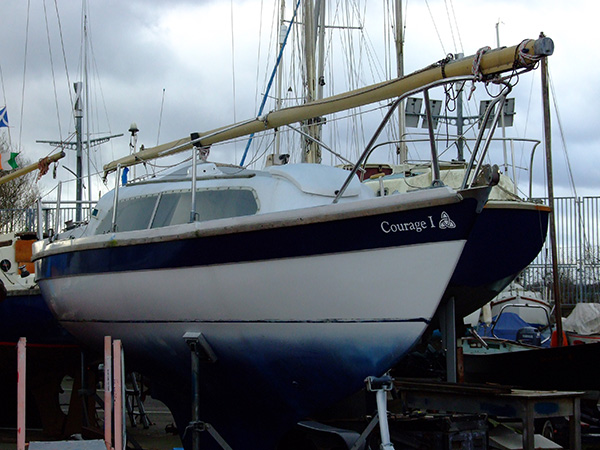The boat was partly painted, nicely sprayed but it was only half of the hull. There was no inboard engine but an old shaft with an outboard propeller. Quite unusual combination. There was no running rigging, boom with not working roll-riffing and new cushions.

Decision was made to begin with an inboard engine installation.
So, the first step was to go on-line and find what options we have and how much information I can find on Galion 22. It was (because it doesn’t exist any more) very good website ‘Galion Owners Association’ where I found many useful details about our boat. Also, because there were few on sale I managed to collect fair amount of pictures. But still many things were a guess work, such as boom fittings.
On the engine front, I considered: Yanmar one and two cylinder; Beta Marine; Nanni, Farryman/Bukh; Westerbeke and Vetus. Important factors were: power, weight, size and lastly price. Also, I was looking at electric motors but cost and battery weight were prohibitive.
The best candidates were Yanmar 1GM10, Beta Marine 10 and Nanni N2.10 and our winner was Yanmar, as the smallest, lightest and available second-hand.
We found one on eBay for £1500 with gearbox. According to the seller it was fully reconditioned, however it turned out not to be after the purchase and very close examination and it became another task on its own. At the seller’s workshop it started fairly easy but was emitting enormous amount of black smoke, which was explained to us as the result of oil on cylinder after reconditioning and it will stop when the oil will fully burn out. Nothing more misleading. For the extra £50 we got new control panel.
After we brought it in to the Greenwich Yacht Club, where the boat is I inspected the engine fully and found that an oil was old in both the engine and a gearbox, breather was clogged, valves were off settings, an anode was ‘eaten’, water pump was leaking, impeller broke soon after, thermostat rusted and stuck, fuel filter dirty and some bolts, brackets and fittings were missing. Lesson learned: be vigilante and careful but unfortunately many things cannot be seen on the spot without lots of unscrewing. The only thing was an oil I forgotten to check. This would show how bad it was.
Anyway, I build a list of parts needed, well not so fast. I spent some time searching for the engine’s manual and parts catalogue. Quite a task on its own but successful, so the list was made and parts ordered. Of course battery and cables were ordered too as we had none.
For the convenience I have created a page with links to all documents, manual and catalogue I found on-line.
After couple of hours the engine was ready for its first run and it started immediately with no smoke whatsoever. Happy time 🙂
Because for this first time I connected running water from the tap I didn’t notice a problem with an impeller but only a leaking pump. So, after replacing seals in the pump and letting engine suck water from a bucket the impeller issue came to my attention as its inside metal ring broke from the rubber and no water was coming out of the exhaust. Later I found that this type of issue happened even with new impellers and it was due to faulty manufacturing. However, since than the engine works fine.
The next step was the engine installation. But to be fully honest, I’m a bit chaotic and I move from one task to another and not necessarily in any particular order. So, while working more conceptually on the engine bedding I was looking at all necessary systems such as fuel, cooling or exhaust I buying elements and fitting them such as seacock. But regardless of anything, the goal was to have all systems in places before the engine being seated on the bedding. More details are on Engine Bedding pages.
There were many other things to do. The deck and cockpit had to be painted, new running rigging fitted, the bow roller was damaged and there was no anchor. The safety lines on the stanchions had to be replaced and I wanted netting fitted too. The mast and the boom had to be sorted, I mean nav lights, antenna, windex should go on the mast and boom needed change from roller-reefing to slab-reefing, fit lazy jacks, boom lift and main sheets bracket. The radio and chart plotter had to be fitted too as well as compass and some other navigational instruments. I also wanted to build a map table, very useful item on the boat. So, I did it before the 2014 season.
We needed some safety items such horseshoe buoy, first aid kid, MOB throw line, secondary anchor, search light and other equipment such as fenders, hand bilge pump, mooring lines, bosun hook or ladder, not saying anything about tools, fittings and fixings as well as sailing and rigging related items. The list of needed items crossed 500 and tasks big and small passed well over 100.
I will do my best to tell you most about how and what we did but I would like to hear from you too, about your own experiences and things you have done on your boats. I will share your views in the form of guest posts.
Any suggestions are very much welcome. This is to benefit of all Galion 22 current and future owners.